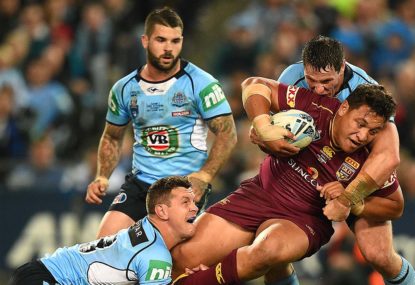Kenny Bromwich ruled out of game with concussion after nasty collision with Knights enforcer
The Dolphins forward copped an accidental shoulder to the head while trying to tackle Leo Thompson, and subsequently failed his HIA, ruling him out…

It’s State of Origin time, where the Joshes of New South Wales (Morris, Mansour and Jackson) and the Joshes of Queensland (McGuire and Papalii) return to the states for which they made their senior Josh debut.
They track down a handful of Coreys, Boyds and Blakes to round out their respective teams and then play a game of rugby league in between advertisements urging us to gamble a lot more than we’re currently doing.
Here are the ratings from the first State of Origin.
Mind Games
Grade: A-
The mind games that take place between the two camps before any State of Origin game are an integral part of the theatre of the contest, in spite (or perhaps precisely because) of how incongruous the concept of psychological warfare might seem in a sport as physically brutal as rugby league.
It’s like how the most fascinating part of the World Chess Championships is the pre-tournament tractor pull. Or the intrigue of the salad-eating contest just prior to the World Professional Darts Championship.
More from State of Origin 1:
» Five talking points
» The big issues examined
» Laurie Daley drops a post-Origin bombshell
» State of Origin Game 1 full time: Queensland hold on to win
» All the action in our live blog
This time around, most of the mind games centred on the fitness of Queensland halfback and rejected ute brand name, Cooper Cronk.
‘Can Queensland’s cool co-kicker Cooper Cronk conquer crook cankle cartilages?’ was the tongue-twister the Maroons threw out.
In response, New South Wales ‘claimed quiet confidence Cooper Cronk could’.
Honours even then.
Word Sketches
Grade: D
As always, the pre-match mind games give way to the pre-match entertainment, where the disappointing choice was made to eliminate the most entertaining aspect of previous Origin series – Ray Warren’s Player Word Sketches.
Remember how Ray used to introduce the players by painting a picture of each player in just three or four sentences by saying things like:
“Daly Cherry-Evans – always wanted to set fire to a leprechaun. Tonight will use his hyphen to inspire Queensland to victory.”
or
“The Morris twins – yet to be convicted of vehicular manslaughter. Their combination will be key.”
or
“Sam Thaiday – born six feet off the ground and grew downwards. Was married at first sight.”
or
“Robbie Farah – cannot be swayed of the belief that he is the reincarnation of Marie Curie. Needs to run from dummy half.”
No such luck this year. And nothing really to take its place. Not even some kind of television poll asking home viewers to speculate on important rugby league matters. For example, when the VB Blues and the XXXX Maroons collide, what animal’s urine does the result most resemble?
Maybe next game.
Cameron Smith
Grade: B+
One player who needed no introduction was, of course, Cameron Smith, the Queensland, Melbourne, Australia and Millennium Falcon captain.
Smith became the most-capped player in State of Origin history, surpassing Darren Lockyer, who, embarrassingly, has taken to wearing all 36 of his caps at the same time. A poorly thought-out path to Immortality from Lockyer there.
Still, despite all the acclaim, Smith has played in fewer than 35 per cent of State of Origin matches. So let’s not get too carried away by him.
Limited attacks
Grade: F
Apart from Cameron Smith’s shameless display of his vast experience, there was little else to recommend the game. Both teams displayed St George-Illawarra levels of attacking prowess, scoring just the one try apiece in the first half.
Boyd Cordner scored the first for New South Wales when it was revealed that Cronk’s ankle had been reattached the wrong way around and he could only run backwards in defence.
Queensland struck back shortly after when Johnathan Thurston decided to run the ball on the last tackle and combined with Darius Boyd to put Dane Gagai over in the corner. This, of course, led to one of the more unwelcome spectacles the game of rugby league has to offer – namely, a jubilant Darius Boyd.
With neither try converted, a high tackle penalty against Paul Gallen led to the difference between the two teams at halftime. Gallen would be disappointed – if you’re going to give away a penalty for hitting somebody in the head, you should at least take the opportunity to go punch Nate Myles.
Axioms of Reflexivity
Grade: A
With Queensland up 6-4 at half-time, and neither team able to score in the second half, the fundamental mathematical Axiom of Reflexivity came into play. This, as any member of the Queensland coaching staff would tell you, is the principle that states that if things are the same as one another then they’re the same as one another.
And, as a result, the full-time score remained 6-4.
The Blues had their chances in the second half of the game. Josh Morris got over the line but was denied a try by strong Queensland defence and even stronger Bunker super-vision and/or guesswork.
Also, at one point, David Klemmer took it upon himself to run over the faces of Queensland players – a tactic that worked splendidly until he mysteriously abandoned it.
And, of course, the New South Wales team could have simply spent the entire second half taking shots at a field goal. Surely three of them would have gone over in 40 minutes.
But, alas, it wasn’t to be for Laurie Daley’s men. Queensland hung on and will go to Suncorp Stadium fully aware of the vital State of Origin statistic that the team that wins the first two matches has gone on to win the series in a hundred percent of cases.